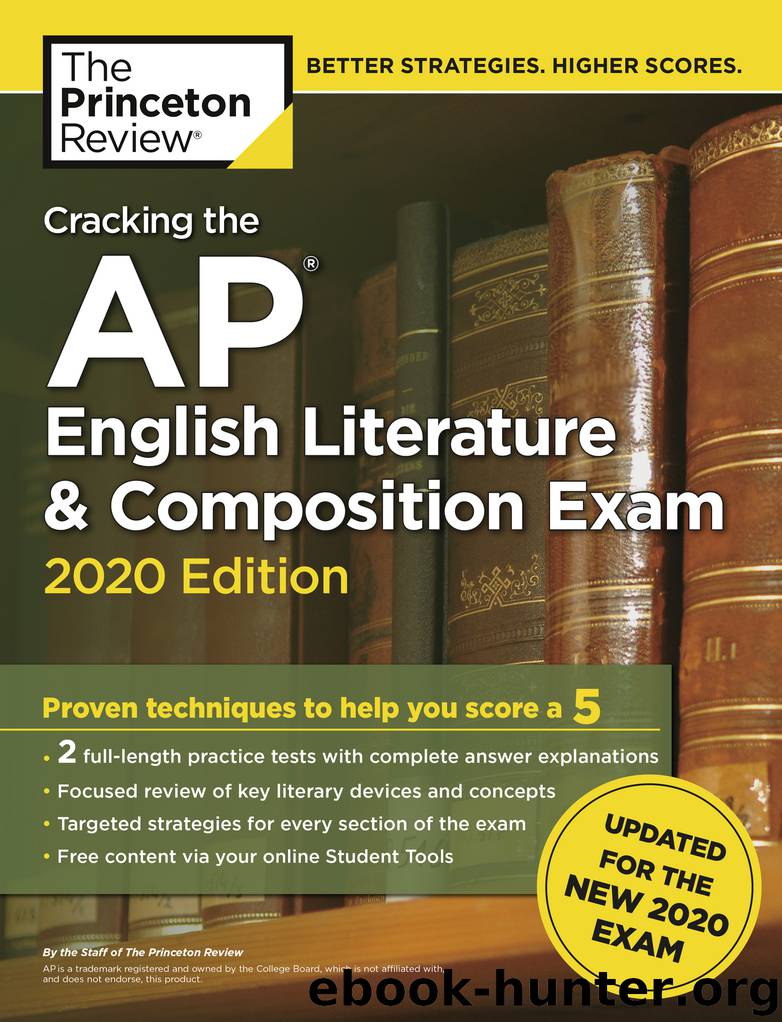Cracking the AP English Literature & Composition Exam, 2020 Edition by The Princeton Review

Author:The Princeton Review
Language: eng
Format: epub
Publisher: Random House Children's Books
Published: 2020-01-27T16:00:00+00:00
POETRY ANALYSIS PASSAGE DRILL 2: ANSWERS AND EXPLANATIONS
About “Skyscraper”
Skyscrapers—a solution to the shrinking amount of land in big city downtown areas—were still a relatively new phenomenon when American poet Carl Sandburg wrote this in 1916. The Wainwright Building in St. Louis, built only 25 years earlier, is often considered the first such building. They were called “skyscrapers” because, in comparison to the surrounding buildings, they were tall enough to scrape the sky.
1. A
Remember, when a question stem sends you to a specific line in a poem, always read at least a line before and a line after in order to understand the context. If you looked only at lines 10–12, you might think the correct answer is (C). In this case, you only need to read one line before—“It is the men and women, boys and girls so poured in and out all day that give the building a soul of dreams and thoughts and memories”—to see that the correct answer is (A). The skyscraper has value and permanence and a sense of life by virtue of the people who work in it and maintain it and consider it important, not because of the city in which it stands. Choice (D) is too narrow—people do more than use the building. Choices (B) and (E) aren’t implied: the speaker doesn’t suggest that dumping the skyscraper in the sea would be easy, and doesn’t give his own opinion of the building’s value.
2. E
This question calls for two things: an understanding of the poem as a whole, and an ability to distinguish the poet from the narrator. The first requirement eliminates (C)—there is much more to the descriptions in the poem than an obvious familiarity with the day-to-day routine of working in a downtown office building. Choice (A) is gone for the same reason—the original construction crew is only one of the groups of people the poet describes. In addition, there is no suggestion that he particularly admires them. The poet’s tone is too neutral to suggest either hostility, (B), or veneration, (D), for the building, so eliminate those two choices. That leaves (E). He juxtaposes the “Ten-dollar-a-week stenographers” (line 49) and “the master-men who rule the building” (lines 54–55). He states that, at night, “Scrubbers work, talking in foreign tongues” (lines 62–63) and refers to the blue-collar workers who erected the building so white-collar “corporation officers, lawyers, efficiency engineers” (lines 49–50) could work there. The poet is suggesting a criticism of the class system and gender inequality of his time. Although the narrator’s tone is relatively neutral when he refers to these groups, it is the author who chose to include them in the poem.
3. E
Here’s the Roman numeral format, so approach it first as a standard format question with only three choices. What about Statement (I)? That’s true; each man has something unique in his personal life, whether it’s a “dead child” or “a passionate lover.” Statement (II) is also true; each man has a “driving ambition” for wealth. And
Download
Cracking the AP English Literature & Composition Exam, 2020 Edition by The Princeton Review.epub
This site does not store any files on its server. We only index and link to content provided by other sites. Please contact the content providers to delete copyright contents if any and email us, we'll remove relevant links or contents immediately.
Spare by Prince Harry The Duke of Sussex(5140)
Navigation and Map Reading by K Andrew(5133)
Tuesdays with Morrie by Mitch Albom(4732)
Machine Learning at Scale with H2O by Gregory Keys | David Whiting(4259)
Cracking the GRE Premium Edition with 6 Practice Tests, 2015 (Graduate School Test Preparation) by Princeton Review(4248)
Never by Ken Follett(3884)
Goodbye Paradise(3761)
What It Really Takes to Get Into Ivy League and Other Highly Selective Colleges by Hughes Chuck(3716)
Harry Potter and the Prisoner of Azkaban (Book 3) by J. K. Rowling(3324)
Fairy Tale by Stephen King(3307)
Pledged by Alexandra Robbins(3152)
Kick Ass in College: Highest Rated "How to Study in College" Book | 77 Ninja Study Skills Tips and Career Strategies | Motivational for College Students: A Guerrilla Guide to College Success by Fox Gunnar(3100)
A Dictionary of Sociology by Unknown(3044)
Sapiens and Homo Deus by Yuval Noah Harari(3029)
Reminders of Him: A Novel by Colleen Hoover(3011)
The Social Psychology of Inequality by Unknown(2987)
Graduate Admissions Essays, Fourth Edition: Write Your Way into the Graduate School of Your Choice (Graduate Admissions Essays: Write Your Way Into the) by Asher Donald(2890)
Will by Will Smith(2872)
Zero to Make by David Lang(2753)
